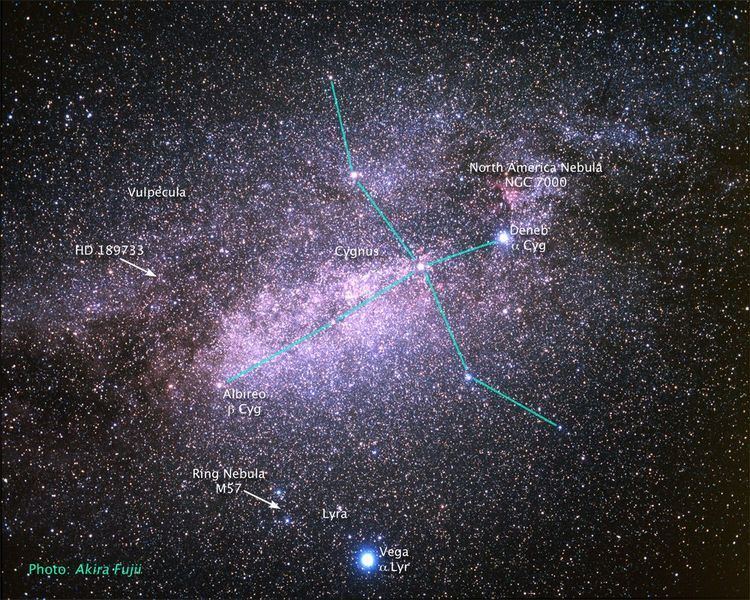Companion HD 189733 B | ||
 | ||
HD 189733, also catalogued as V452 Vulpeculae, is a binary star system approximately 63 light-years away in the constellation of Vulpecula (the Fox). The primary star is suspected to be an orange dwarf star, while the secondary star is a red dwarf star. Given that this system has the same visual magnitude as HD 209458, it promises much for the study of close transiting extrasolar planets. The star can be found with binoculars 0.3 degrees east of the Dumbbell Nebula (M27).
Contents
As of 2005, it has been confirmed that an extrasolar planet orbits the primary star within the system.
Stellar system
HD 189733 A is an orange dwarf star of the spectral type K1.5V. The star has a mass of 81 percent that of the Sun, a radius 76 percent, and a luminosity of 33 percent. The star is between 89 and 102 percent as enriched in iron as the Sun, making the star more than 600 million years old.
The star has starspots which affect its luminosity by 1.5 percent in visible light. As a result, it is listed in the General Catalogue of Variable Stars as a BY Draconis variable with the variable star designation V452 Vul.
Discovered in 2006 by the infrared 2MASS astronomical survey, 2MASS J20004297+2242342 or HD 189733 B is a dim red dwarf star of spectral type M. The companion was observed at a separation of 216 astronomical units away from the primary star. Orbiting in a clockwise orbit (which is nearly perpendicular to the orbital plane of transiting planet HD 189733 b), the orbital period is estimated around 3,200 years long.
Planetary system
HD 189733 A has one known planet, designated HD 189733 b, a gaseous giant 13% larger than Jupiter close enough to complete an orbit every two days. Using spectrometry it was found in 2007 that this planet contains significant amounts of water vapour. This planet is the second extrasolar planet where definitive evidence for water has been found.
The chemical signature of water vapour was detected in the atmosphere of this planet. Although HD 189733b with atmospheric temperatures rising above 1,000 °C (1,830 °F) is far from being habitable, this finding increases the likelihood that water, an essential component of life, would be found on a more Earth-like planet in the future.
Astronomers have created a rough map of HD 189733b's cloud-top features using data from the Spitzer infrared space telescope.
Although Spitzer could not resolve the planet into a disk, by measuring changes as the planet rotated, the team created a simple longitudinal map. That is, they measured the planet's brightness in a series of pole-to-pole strips across the planet's visible cloud-tops, then assembled those strips into an overall picture.
Probably due to strong winds, the hottest point on the planet seems to be "offset by about 30 degrees longitudinally" from the substellar point ("high noon").
In late 2008, the spectral signature of carbon dioxide was found in HD 189733b's atmosphere.
In 2013, albedo measurements at visible wavelengths in the range of 290–570 nm using the Hubble Space Telescope STIS (Space Telescope Imaging Spectrograph) instrument, reported in the Astrophysical Journal Letters, determine the planet to have a deep blue hue due to optically thick reflective clouds containing silicates (glass) "rain". The paper detailing the results reports measurement of "geometric albedos of Ag = 0.40 ± 0.12 at 290–450 nm [near ultraviolet to blue in the visible light region of the electromagnetic spectrum] and Ag < 0.12 at 450–570 nm ... with sodium absorption suppressing the scattered light signal beyond ∼450 nm as predicted by models of hot Jupiter atmospheres."
